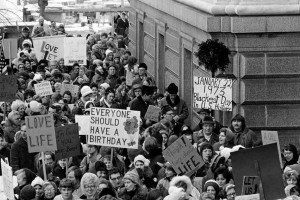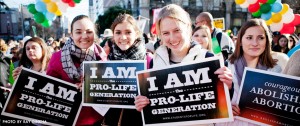Continuity Amongst Change
In the past nineteen years of my life, I have seen terrorists attack our country and forever change our national security, I have seen the first African-American president voted into office, and I have witnessed a world become fully electronic. Amongst all of these MAJOR changes, it is rare to experience continuity, especially in social issues such as abortion. Yet, evidence shows that political opinion on abortion, “an issue that blends gender, sexuality, and religion seem(s) to have changed little since the 1970’s”, even though each one of these components have changed drastically in the last forty years (Fischer, 1). So, what exactly creates activists in my generation?
If we take a look at the history of the abortion debate, we see a lot of flip-flopping of political legislation on the issue, which will further explain the current power of the abortion movement. Before the 1800’s, it was permitted up until the “quickening period”. Then we noticed that “doctors made abortion an issue during the nineteenth century as a platform for asserting their monopoly on scientific medical knowledge”, which contributed to the belief of abortion as murder. But society found the loophole in new policies and created “therapeutic abortions”. As rationales for therapeutic abortions were increasing, physicians were becoming worried because abortion was no longer a life or death issue due to new technological innovations. Tightening legal restrictions on abortion, in the form of “therapeutic abortion committees”, encouraged the act of illegal abortions. This was when people rallied for liberalization on abortion laws around 1950 because death rates among women were increasing due to unsafe illegal abortions. At this point, “abortion was a medical concern rather than a moral or political one,” (Munson, 81). But in the 1960’s, birth defects caused by Rubella and the Finkbine scandal brought abortion into the spotlight, just in time for the Roe v. Wade court decision.
Evidence shows that “for most activists today [Roe v. Wade] did not mark the moment they first became involved in pro-life activism”, (Munson, 84). For activists to join a movement they have to personally identify with “the social dynamics and activities of social movements”, (Munson, 84). Through the Catholic Church, a national pro-life movement was set up. Shortly after the Roe v. Wade and Doe v. Bolton decisions in 1973, pro-life activists, largely influenced by the Church, met up to organize and plan a response. Here the National Right to Life Committee was created, and even though it used the basic infrastructure from the Catholic Church’s organization, it took the Catholic Church out of the equation to ensure widespread support. Movement organizations have not slowed down since 1973. They are even more efficient and more present today than they were then due to their surplus of resources, educating and encouraging activists of my generation.

